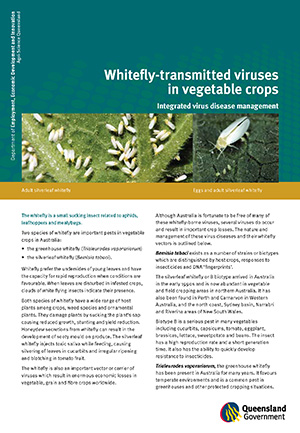|
|
The whitefly is an important carrier of viruses which cause enormous economic losses in vegetable, grain and fibre crops worldwide. The whitefly is a small sucking insect related to aphids, leafhoppers and mealybugs. This 6 page factsheet provides information on plant viruses transmitted by whiteflies which are important to the Australian vegetable industry. Authors : Key Points: Two species of whitefly are important pests in vegetable crops in Australia:
Whitefly prefer the undersides of young leaves and have the capacity for rapid reproduction when conditions are favourable. When leaves are disturbed in infested crops, clouds of white flying insects indicate their presence. Both species of whitefly have a wide range of host plants among crops, weed species and ornamental plants. They damage plants by sucking the plant’s sap causing reduced growth, stunting and yield reduction. Honeydew secretions from whitefly can result in the development of sooty mould on produce. The silverleaf whitefly injects toxic saliva while feeding, causing silvering of leaves in cucurbits and irregular ripening and blotching in tomato fruit. Integrated management methods that reduce or eliminate insecticide use are encouraged for whitefly management as these insects, particularly silverleaf whitefly, rapidly develop resistance to insecticides, resulting in management crisis. The aim is to maximise cultural and biological controls and minimise insecticide use. See Also : Acknowledgements : This technical reference note has been produced by Denis Persley and Cherie Gambley (DEEDI) as part of the Horticulture Australia Limited project VG-07128-Integrated management of viral diseases in vegetables. This project has been facilitated by State Governments, and Horticulture Australia Limited (HAL) in partnership with AUSVEG through the National Vegetable Research and Development Levy. The Australian Government provides matched funding for all HAL’s R&D activities. |
|

